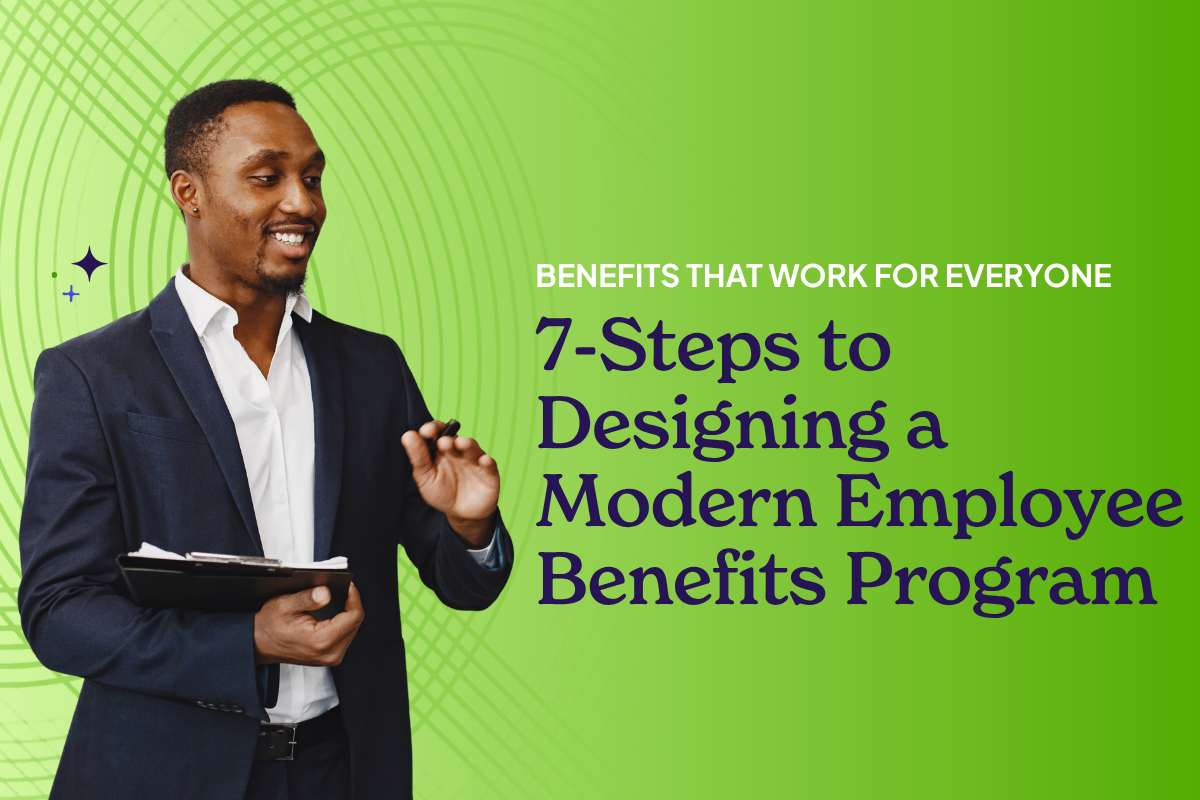Your 7-Step Guide on How to Design an Employee Benefits Program

Designing an employee benefits program is one of the most high-impact decisions an HR or business leader can make. It’s also one of the most complex.
Between compliance regulations, shifting employee expectations, and budget pressures from leadership, it can be hard to know where to start—or how to improve an existing plan that just isn’t cutting it anymore.
But building a strong, strategic benefits program doesn’t require guesswork. With the right approach, you can craft a plan that supports your people, fits your budget, and drives real business outcomes.
Whether you’re designing a benefits package for the first time or revamping one that’s overdue for an update, this article walks you through everything you need to know: from foundational components and plan structure to workforce alignment and real-world examples.
Key Elements of a Strong Employee Benefits Program
Before diving into plan design steps, let’s start with the basics. A well-rounded benefits program includes more than just health insurance. It reflects your organization’s values, supports different employee needs, and helps attract and retain top talent.
Here’s how a modern benefits package typically breaks down:
Core Benefits
These are the must-haves. They often include:
- Health Insurance: Medical, dental, vision
- Life Insurance & Disability Coverage: Short- and long-term disability, basic life
- Retirement Plans: 401(k) or 403(b) plans with optional employer match
- Paid Time Off (PTO): Vacation, holidays, sick leave, and paid parental leave
Even small businesses typically start here to remain competitive and meet regulatory standards.
Supplemental and Lifestyle Benefits
This is where you can tailor your offering to stand out, and meet the evolving needs of your workforce.
- Mental health and therapy benefits
- Fertility or family-building assistance
- Student loan repayment or tuition support
- Commuter benefits or remote work stipends
- Pet insurance or wellness, legal services, identity protection
The more customizable and employee-centric your benefits are, the more likely your team is to engage with them. Be sure to survey your employees regularly for their perspective.
Compliance and Legal Considerations
Benefits compliance is critical and can be a major source of stress without the right systems in place.
You’ll need to navigate:
- ACA and COBRA requirements
- HIPAA compliance
- Non-discrimination testing (especially for FSAs and self-funded plans)
- State-specific mandates (such as paid family leave laws)
Need a refresher on compliance? Visit our Benefits Compliance solutions to see how Selerix can simplify reporting and help you stay audit-ready.
How to Design an Employee Benefits Program in 7 Steps
Now that you understand what goes into a benefits program, let’s break down the process of building one, step by step. These stages apply whether you’re building from scratch or refining a plan that’s outgrown your team’s needs.
Each step is an opportunity to align your benefits offering with your workforce, your values, and your budget.
Step 1: Set Clear Objectives for Your Benefits Strategy
Before picking plans or comparing carriers, get clear on the why behind your benefits program. Ask your team:
- What goals are we trying to achieve?
- Are we competing for top talent? Reducing turnover? Supporting employee wellbeing?
- What budget or cost parameters do we need to meet?
Your objectives should drive every decision that follows, especially when weighing trade-offs between coverage breadth and cost control.
Looking to improve experience and manage costs? Check out this guide for strategies that do both.
Step 2: Understand Your Workforce Demographics
Different employees need different benefits. Use internal data and feedback to understand your population:
- Age, family status, and tenure
- Remote vs. on-site roles
- Employee feedback on current offerings
- Utilization rates from past years
This insight helps you tailor your mix, prioritizing what your people will actually use and value. For example, our 2025 Employee Benefits Survey found that only 27% of employees say they understand their benefit options “perfectly” and for younger workers, the number is even lower.
Want help collecting feedback? We’ve got a post on how to use employee feedback in benefits planning.
Step 3: Benchmark Against Industry Standards
Employees don’t just compare your benefits to their last job—they compare them to the market. Use industry benchmarks to ensure you’re competitive on:
- Employer contribution rates
- Coverage options
- Voluntary benefits offered
- Time-off policies
You don’t need to do this alone. Resources such as SHRM, Selerix support, or your broker partner can provide assistance. If you’re in a tight labor market, above-average benefits could be your edge.
Step 4: Choose and Structure Your Benefits Mix
Now comes the creative part: building your offering. Start with core benefits, then layer in supplemental options to support your broader goals.
A few tips:
- Bundle related offerings (e.g., wellness + mental health)
- Offer voluntary options that allow employees to opt in without adding employer cost
- Keep the structure simple — employees shouldn’t need a decoder ring to enroll
Tools like Selerix BenSelect can help structure your benefits mix in a way that’s flexible, intuitive, and scalable.
Step 5: Select and Vet Vendors
Your carrier and vendor partnerships are a critical extension of your HR team. When evaluating providers, consider:
- Coverage quality and cost
- Support responsiveness
- Digital experience (for both HR and employees)
- Integration with your current systems
If you’re using a benefits administration platform like Selerix, make sure it integrates easily with your carriers and payroll provider to eliminate manual handoffs.
Step 6: Communicate Benefits Effectively
Even the best-designed plan fails if no one understands it.
A strong communication strategy helps employees understand what’s available, what’s changed, and how to make smart choices.
With Selerix Engage, HR teams can send personalized, timely communications through text, email, or portal messages—meeting employees where they are and eliminating the “I never got it” excuses.
Explore year-round employee communication tools.
Step 7: Review and Optimize Annually
A benefits program isn’t set-it-and-forget-it. Make time each year to:
- Analyze enrollment and utilization data
- Gather employee feedback
- Track changes in workforce needs
- Assess new options or cost changes from vendors
This is where Selerix can help. Our platforms provide actionable insights across the full benefits lifecycle, enabling you to refine your offerings and report back to leadership with confidence.
What Employees Want Most from a Benefits Program Today
Designing a great plan doesn’t just mean covering all your bases—it means prioritizing the benefits employees actually care about. That starts with understanding what today’s workforce values most.
Recent data shows that while health insurance and retirement plans remain foundational, employees are increasingly looking for:
Mental Health Support
Burnout remains a top concern, and employees now expect more than just an EAP pamphlet. Teletherapy, mindfulness apps, and mental health days are quickly becoming mainstream benefits, and powerful signals of a supportive culture.
Flexibility and Time Off
More employees are prioritizing time over money. Generous PTO, flexible scheduling, and leave policies tailored to real-life situations (like caregiving or bereavement) are seen as indicators of trust and respect.
Financial Wellness
With inflation and rising student debt, financial stress is a constant for many workers. Programs like student loan repayment, financial coaching, or even access to earned wages can make a real difference.
Well-being and Health
According to MetLife’s 2024 U.S. Employee Benefit Trends Study, Among employees at companies that support their well-being: 85% say they plan to stay in their roles, and 65% report improved productivity due to well-being programs. 63% of employees say that their current benefits package helps reduce stress. The more benefits employees are enrolled in, the higher their holistic health.
Want to dig deeper into personalization strategies? Read our article: Elevating Employee Experience Through Personalized Benefits
By prioritizing these high-impact areas, you can ensure your benefits program resonates with today’s diverse workforce, without necessarily increasing your costs.
Employee Benefits Program Examples
Looking for inspiration? These companies have raised the bar by aligning their benefits with employee needs, values, and life stages. You don’t need their budgets to borrow their thinking.
1. Airbnb: Travel Credit That Reflects the Brand
Airbnb doesn’t just provide a paycheck, they help employees explore the world. Their $2,000 annual travel credit (usable on Airbnb listings) reinforces their brand and encourages rest, exploration, and global connection. It’s a lifestyle benefit that doubles as cultural reinforcement.
Lesson for HR teams: Benefits can reinforce your mission. If you value flexibility, connection, or wellness, your benefits should prove it.
2. Netflix: Flexible Leave
Netflix offers flexible time off and paid parental leave—an uncommon policy in corporate America. Employees can take vacation without a prescribed policy and parents can return part-time, full-time, or come back when they’re ready. It’s a statement about trust and long-term investment in talent.
Lesson for HR teams: Supporting employees through life transitions builds loyalty—and shows you see them as more than just a worker.
3. Patagonia: Onsite Childcare and Family Support
Patagonia has offered on-site childcare for decades and provides parents with financial support for caregiving. More than 90% of their new mothers return to work—a number far above the national average.
Lesson for HR teams: Benefits that reduce life stress make it easier for employees to stay and succeed—especially for caregivers.
These programs are bold—but you don’t need to be Netflix to make an impact. Even small shifts — like improving employee communication, offering new voluntary benefits, or adjusting leave policies — can dramatically improve how employees feel about work.
Take the Next Step: Build a Future-Proof Benefits Strategy
Designing an employee benefits program isn’t about ticking boxes. It’s about building trust, boosting retention, and showing your people they matter.
Whether you’re a growing company creating your first benefits plan or a seasoned HR pro revisiting an outdated offering, Selerix helps you design, deliver, and optimize a program that works for everyone—without added complexity.
Bring clarity to your benefits experience.
Selerix gives HR teams the tools to design flexible plans, deliver personalized, research based communications, and stay compliant every step of the way. Get in touch for a personalized tour or explore our platform to start building a better benefits strategy today.

